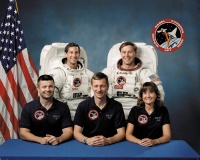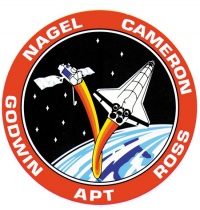STS-37
From The Space Library
 | |
| Organization | NASA-OfficeofSpaceFlight(UnitedStates) |
|---|---|
| Mission type | Human Crew |
| Launch date | April 5, 1991 |
| Launch vehicle | Space Shuttle |
| Carrier rocket | {$Carrier Rocket} |
| Launch site | Cape Canaveral, United States |
| COSPAR ID | 1991-027A |
| Mass | {$Mass} |
| Experiments | Here |
| Alternate Names | 21224 |
| Nominal Power | {$Nominal Power} |
| Additional Information | Here |
| Telecommunications Information | Here |
| Data Collection | Here |
| Payload Mass Up | 16611.0 kg |
STS-37 was the eighth flight of the shuttle Atlantis and the 39th shuttle flight. The orbiter weighed 115,502 kg at launch; total vehicle weight was 2,047,178 kg. Much of the load was the Gamma Ray Observatory (GRO), at 15, 620 kg the heaviest shuttle-launched payload to date. STS 37 was staffed by Commander Steven R. Nagel, Pilot Kenneth D. Cameron, Mission Specialists Linda M. Godwin, Jerry L. Ross and Jay Apt. GRO deployment was scheduled from mission day three; an EVA to test conveyance carts and construction aids for large space structures was on the docket for day four. As it happened, GRO deployment was delayed and the first spacewalk since 1985 commenced a day early. Plans were changed by a stubborn antenna. Midway though GRO's deployment sequence, while still attached to the remote manipulator arm, the satellite's high gain antenna boom stuck in its stowed position. Repeated maneuvers to free it failed. Astronauts Ross and Apt were called on to free the boom by hand. Seventeen minutes after the pair exited Atlantis, Ross released the boom. GRO was ultimately cast into orbit only 4.5 hr later than planned. While outside the shuttle, Ross and Apt began the scheduled equipment tests, evaluating hand rails and foot restrains. They reentered the shuttle after 4 hrs, 38 mns. Outdoor activities resumed the next day, with the team testing manual and electric personnel carts during a 6-hr, 11-mn EVA. Several times during the flight, Atlantis passed within view of the Mir station. The crew attempted to contact their Soviet conterparts via ham radio, but were unsuccessful. Landing was delayed one day by gusty winds at Edwards AFB. The 5-day, 23-hr, 33-mn mission concluded on Edward's runway 33 at 13:55, April 11.

